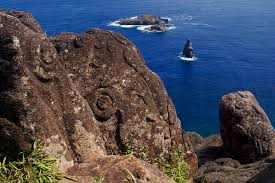JULY 8, 2013

As promised by those in the non-physical, we continue to learn more about pyramids that apparently pepper the surface of our planet in previously undisclosed or little-known places.
The article below, with outstanding photos from several archeological sites, is really exciting because it exposes more of the lost history of Earth that we have not previously been privy to in our history books.
The evidence supports the theory that there are too many similarities in various pyramids on the planet and their adornment for them to have occurred in multiple cultures over thousands of years, by chance.


I couldn’t help but notice the distinct similarity in the styling of the birds in this complex to this “egg” depicting the “bird man” (below) that we brought back from Easter Island. Both have the same stylized head, and the more human-like kneeling body.
 The Bird Man—half man, half bird— is the centre of a key ancient ritual on Easter Island in which the men who were deemed qualified to be the next chief, climbed down a huge cliff to the sea, swam to the bird island, climbed up the cliff, took an egg from a nest in the rookery, placed it in a specially designed cloth pouch on their head and then made their way back to the tribe on the main island. The first man to return with an egg intact was the new chief.
The Bird Man—half man, half bird— is the centre of a key ancient ritual on Easter Island in which the men who were deemed qualified to be the next chief, climbed down a huge cliff to the sea, swam to the bird island, climbed up the cliff, took an egg from a nest in the rookery, placed it in a specially designed cloth pouch on their head and then made their way back to the tribe on the main island. The first man to return with an egg intact was the new chief.

Wouldn’t it be an awfully big coincidence for two primitive cultures separated by roughly 2400 miles of ocean to place such reverence on a bird, particularly one so similar in appearance, in depictions in their art?

Easter Island / Rapa Nui stonework

Inca stonework, Peru
After visiting the ruins of Peru, Mexico, Guatemala and Easter Island, it’s impossible not to note the identical rock cuts and precision fitting of megalithic stones comprising monuments and buildings in those areas.
Whoever built those structures wasn’t limited to one continent, and I don’t personally believe they cut this exceptionally hard rock with stone chisels as the tour guides and books claim.
It’s certainly food for thought to consider that the continents were once either one land mass, or separated by much less water at some point in history—probably pre-Atlantis, before it broke apart and sank.
If you are fascinated by pyramids, ancient culture, archeology and history, I highly recommend visiting the originating web site to read more and see the many outstanding photographs from various pyramid complexes in Peru.

The Caral Pyramid Complex, just three hours north of Lima is one of the largest Pyramid fields in the world and is even officially noted as the oldest city of the Americas. It’s construction is attributed to the Norte Chico civilization, a pre-columbian society that ruled Peru’s northern coast more than five thousand years ago. According to mainstream archaeology the Caral complex was built a millennium after Sumer in Mesopotamia and contemporaneous with the building of the Egyptian Pyramids. Caral predates the Olmec culture by two millennia and is also only one of six places in the ancient world where civilization originated separately. Meaning there was no prior contact and all these civilizations just happened to rise up out of nowhere on their own. And build pyramids no less!
Looking at the ancient pyramid fields of Caral and being free from the chains of having to fit everything into the false timeline of mainstream history, we can clearly see that the pyramids of Peru are far more archaic than five thousand years. Even the civilization that supposedly built them lacked ceramics, writing and apparently had almost no art, yet they somehow built monumental structures, including large earthwork platform mounds and sunken circular plazas. That is because the society archaeology attaches to the Caral complex didn’t build the original megalithic monuments found buried underneath the various layers of rocks that the Norte Chico and later Moche Indians rebuilt.
This theme is repeated throughout history when the subject of an ancient or forgotten culture leaves behind unexplained monuments. For example, the mysterious Mounds that litter the Ohio valley and Southeastern America are attributed to local Natives despite the Indians themselves claiming they never built the mounds and that a lost race had built them ages ago.
Mainstream archeology ignores this fact, dismisses indigenous traditions and continues writing their own version of history anyways. This scenario is repeated at Caral, as the Indians associated with the site seem to have just moved in and occupied the place and then vanished at some point in the past. But bones and pottery shards discovered near the pyramids does not prove the people associated with them actually built the original complexes. There are more pyramid sites found within the general area of Caral, and because of the close proximity of the ocean it makes sense that these sites were built in an era when the shoreline was closer. Caral also exhibits archeological similarities with ruins found in Ancient turkey. Even examples of Cyclopean Greek architecture show up in Caral. Some of the ruins even look like they could be sitting in a desolate desert in Egypt.

Read more and see additional photos…